The Role of Air Conditioning Adaptation in Mitigating Compound Day–Night Heatwave Exposure in China Under Climate Change
Abstract
1. Introduction
2. Materials and Methods
2.1. Dataset
2.2. Definition of CDNH
2.3. Air Conditioning (AC) Penetration
2.4. Population Exposure to CDNH and Effects of AC Adaptation
2.5. Comparing the Contribution of AC, Climate, and Population to the Exposure Changes
2.6. Identification of Urban and Rural Areas
3. Results
3.1. The Spatio-Temporal Characteristics of CDNH
3.2. Population Exposure to CDNH and the Effect of AC Adaptation
3.3. The Contribution of AC, Climate, and Population to the Changes in Exposure
4. Discussion
5. Conclusions
Author Contributions
Funding
Institutional Review Board Statement
Informed Consent Statement
Data Availability Statement
Conflicts of Interest
Abbreviations
| CDNH | Compound day- and night-time heatwaves |
| AC | Air conditioning |
| GAIA | Global Artificial Impervious Areas |
| GDP | Gross domestic product |
| USD | United States Dollar |
| CNY | Chinese Yuan |
| CPI | Consumer Price Index |
| PPP | Purchasing Power Parity |
| EHF | Excess Heat Factor |
| ME | Mitigating effect |
Appendix A

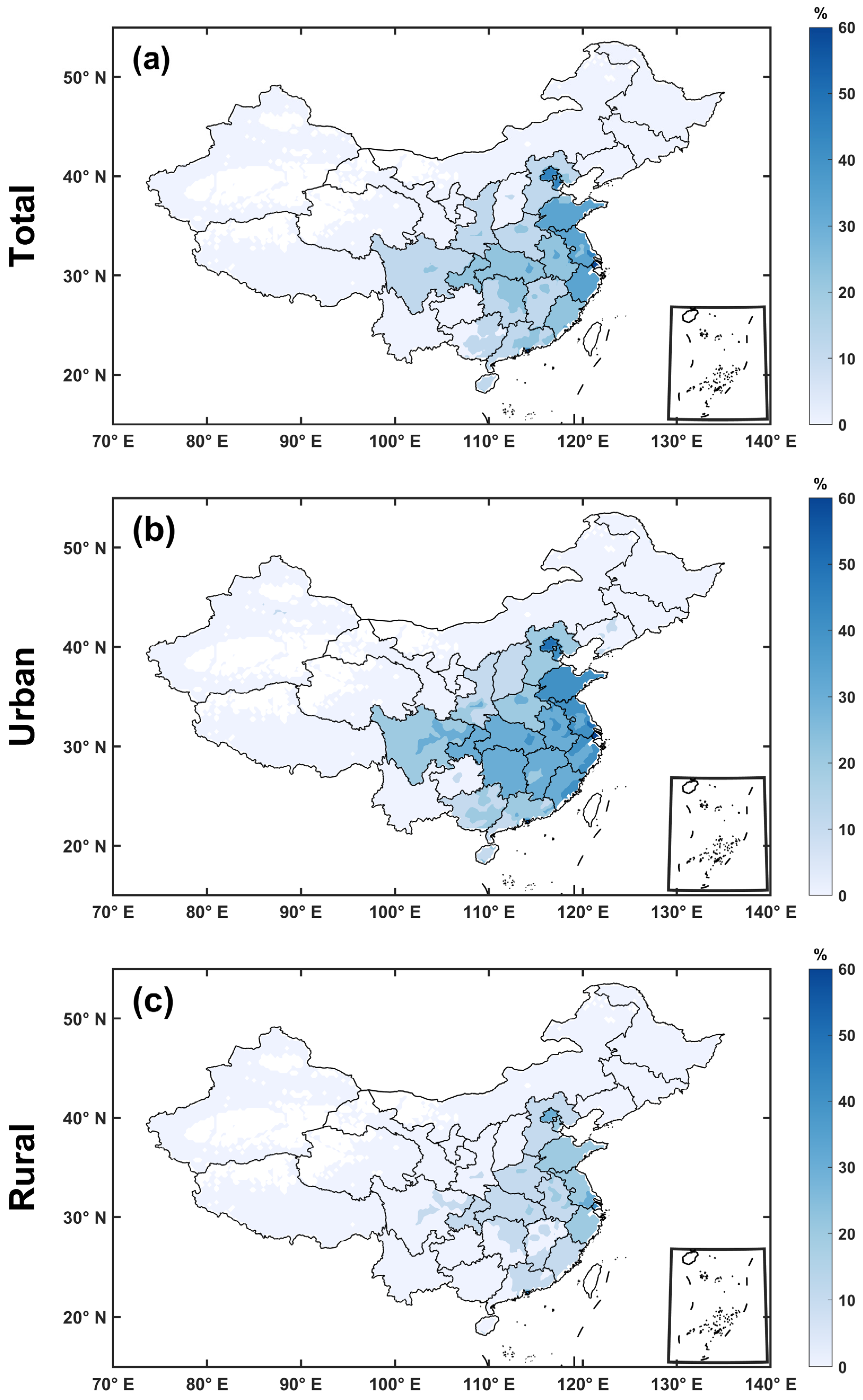

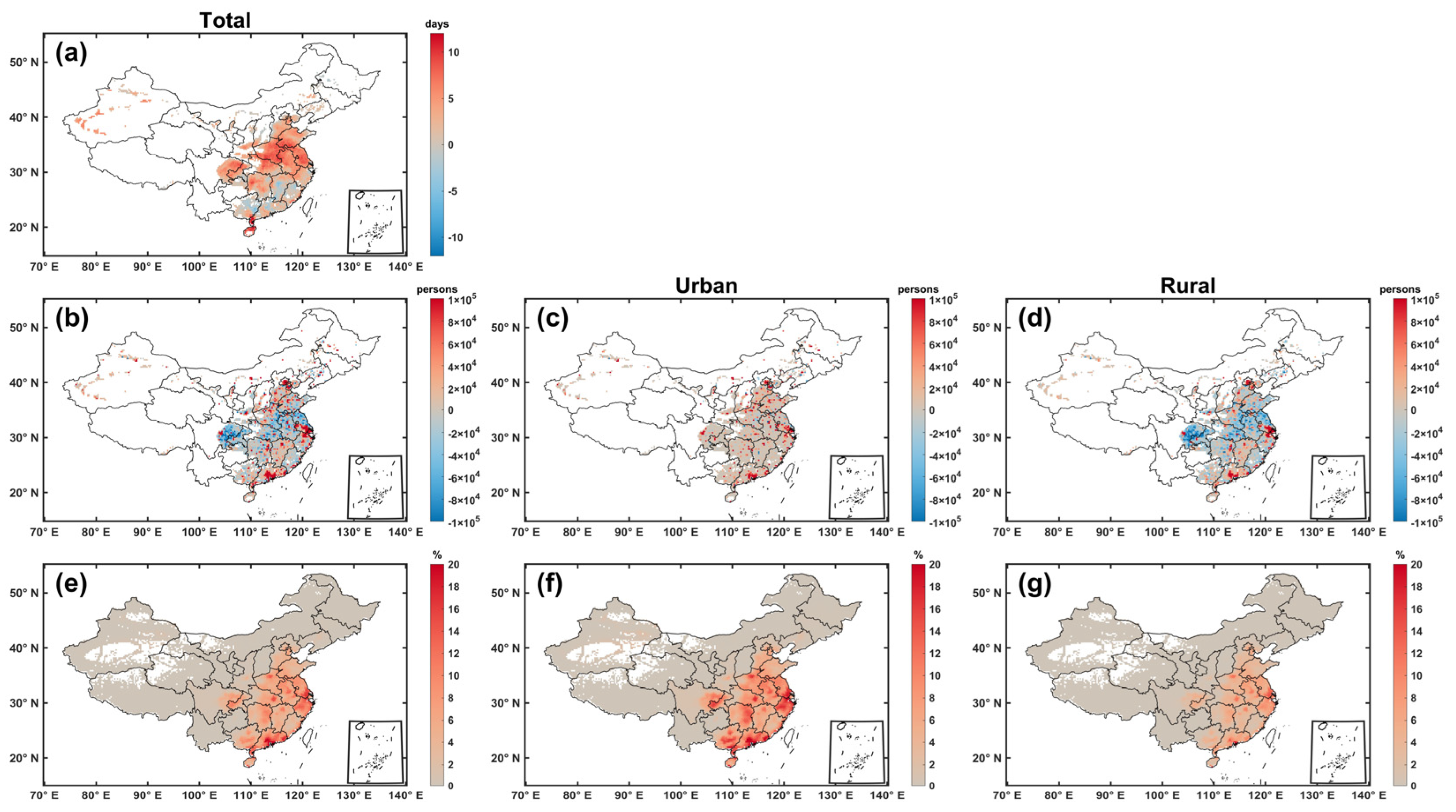
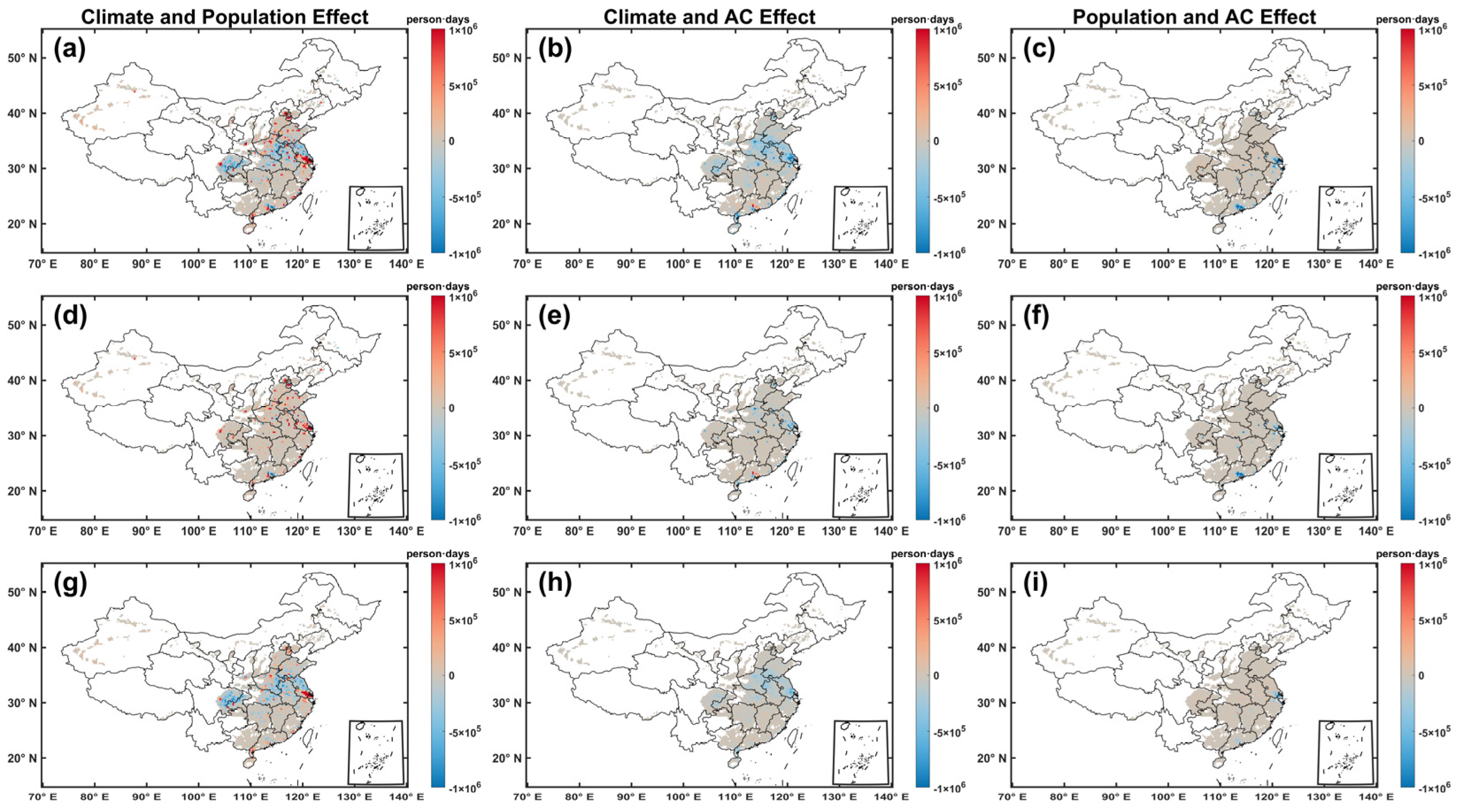

References
- Chen, J.; Liu, Y.; Pan, T.; Liu, Y.; Sun, F.; Ge, Q. Population Exposure to Droughts in China under the 1.5 °C Global Warming Target. Earth Syst. Dyn. 2018, 9, 1097–1106. [Google Scholar] [CrossRef]
- IPCC. Summary for Policymakers. In Climate Change 2021: The Physical Science Basis. Contribution of Working Group I to the Sixth Assessment Report of the Intergovernmental Panel on Climate Change; IPCC: Geneva, Switzerland; Cambridge University Press: Cambridge, UK; New York, NY, USA, 2021; pp. 3–32. [Google Scholar]
- World Meteorological Organization (WMO); World Health Organization (WHO). Heatwaves and Health: Guidance on Warning-System Development; WMO & WHO: Geneva, Switzerland, 2015. [Google Scholar]
- Sun, Q.; Miao, C.; AghaKouchak, A.; Duan, Q. Unraveling Anthropogenic Influence on the Changing Risk of Heatwaves in China. Geophys. Res. Lett. 2017, 44, 5078–5085. [Google Scholar] [CrossRef]
- Xia, J.; Chen, J.; She, D. Impacts and countermeasures of extreme drought in the Yangtze River Basin in 2022. J. Hydraul. Eng. 2022, 53, 1143–1153. [Google Scholar] [CrossRef]
- Arbuthnott, K.; Hajat, S.; Heaviside, C.; Vardoulakis, S. Changes in population susceptibility to heat and cold over time: Assessing adaptation to climate change. Environ. Health 2016, 15, S33. [Google Scholar] [CrossRef] [PubMed]
- Jones, B.; Tebaldi, C.; O’Neill, B.C.; Oleson, K.; Gao, J. Avoiding population exposure to heat-related extremes: Demographic change vs climate change. Clim. Change 2018, 146, 423–437. [Google Scholar] [CrossRef]
- Chambers, J. Global and cross-country analysis of exposure of vulnerable populations to heatwaves from 1980 to 2018. Clim. Change 2020, 163, 539–558. [Google Scholar] [CrossRef]
- Zhou, Y.; Gu, S.; Yang, H.; Li, Y.; Zhao, Y.; Li, Y.; Yang, Q. Spatiotemporal variation in heatwaves and elderly population exposure across China. Sci. Total Environ. 2024, 917, 170245. [Google Scholar] [CrossRef]
- Cai, W.; Zhang, C.; Zhang, S.; Ai, S.; Bai, Y.; Bao, J.; Chen, B.; Chang, N.; Chen, H.; Cheng, L.; et al. The 2021 China report of the Lancet Countdown on health and climate change: Seizing the window of opportunity. Lancet Public Health 2021, 6, 932–947. [Google Scholar] [CrossRef]
- Zhang, S.; Zhang, C.; Cai, W.; Bai, Y.; Callaghan, M.; Chang, N. The 2023 China report of the Lancet Countdown on health and climate change: Taking stock for a thriving future. Lancet Public Health 2023, 8, 978–995. [Google Scholar] [CrossRef]
- Barreca, A.; Clay, K.; Deschenes, O.; Greenstone, M.; Shapiro, J.S. Adapting to climate change: The remarkable decline in the US temperature-mortality relationship over the twentieth century. J. Polit. Econ. 2016, 124, 105–159. [Google Scholar] [CrossRef]
- Biardeau, L.T.; Davis, L.W.; Gertler, P.; Wolfram, C. Heat exposure and global air conditioning. Nat. Sustain. 2020, 3, 25–28. [Google Scholar] [CrossRef]
- Bobb, J.F.; Peng, R.D.; Bell, M.L.; Dominici, F. Heat-related mortality and adaptation to heat in the United States. Environ. Health Perspect. 2014, 122, 811–816. [Google Scholar] [CrossRef]
- Walkowiak, M.P.; Bandurski, K.; Walkowiak, J.; Walkowiak, D. Outpacing climate change: Adaptation to heatwaves in Europe. Int. J. Biometeorol. 2025, 69, 989–1002. [Google Scholar] [CrossRef] [PubMed]
- Han, Q.; Chao, Q.; Sun, S.; Shi, P. Role of adaptation measures in addressing heatwave exposure in China. Adv. Clim. Change Res. 2024, 15, 148–157. [Google Scholar] [CrossRef]
- Ma, F.; Yuan, X.; Wu, P.; Zeng, Z. A moderate mitigation can significantly delay the emergence of compound hot extremes. J. Geophys. Res. Atmos. 2022, 127, e2021JD035427. [Google Scholar] [CrossRef]
- Gao, S.; Chen, Y.; Li, K.; He, B.; Cui, Y.; Peng, H. Changes in day–night dominance of combined day and night heatwave events in China during 1979–2018. Environ. Res. Lett. 2022, 17, 114058. [Google Scholar] [CrossRef]
- Chen, X. Significant Increases in Wet Nighttime and Daytime–Nighttime Compound Heat Waves in China from 1961 to 2020. Atmosphere 2023, 14, 178. [Google Scholar] [CrossRef]
- Li, Z.; Hu, J.; Meng, R.; He, G.; Xu, X.; Liu, T.; Zeng, W.; Li, X.; Xiao, J.; Huang, C.; et al. The association of compound hot extreme with mortality risk and vulnerability assessment at fine-spatial scale. Environ. Res. 2021, 198, 111213. [Google Scholar] [CrossRef]
- Yang, J.; Zhou, M.; Guo, C.; Zhu, S.; Sakhvidi, M.J.Z.; Requia, W.J.; Sun, Q.; Tong, S.; Li, M.; Liu, Q. Drivers of associations between daytime-nighttime compound temperature extremes and mortality in China. Commun. Med. 2024, 4, 125. [Google Scholar] [CrossRef]
- Liu, J.; Kim, H.; Hashizume, M.; Lee, W.; Honda, Y.; Kim, S.E.; He, C.; Kan, H.; Chen, R. Nonlinear exposure-response associations of daytime, nighttime, and day-night compound heatwaves with mortality amid climate change. Nat. Commun. 2025, 16, 635. [Google Scholar] [CrossRef]
- Wang, J.; Feng, J.; Yan, Z.; Chen, Y. Future risks of unprecedented compound heatwaves over three vast urban agglomerations in China. Earths Future 2020, 8, e2020EF001716. [Google Scholar] [CrossRef]
- Liu, J.; Qi, J.; Yin, P.; Liu, W.; He, C.; Gao, Y.; Zhou, L.; Zhu, Y.; Kan, H.; Chen, R.; et al. Rising cause-specific mortality risk and burden of compound heatwaves amid climate change. Nat. Clim. Change 2024, 14, 1201–1209. [Google Scholar] [CrossRef]
- Wang, L.; Rohli, R.V.; Lin, Q.; Jin, S.; Yan, X. Impact of Extreme Heatwaves on Population Exposure in China Due to Additional Warming. Sustainability 2022, 14, 11458. [Google Scholar] [CrossRef]
- Liu, Z.; Anderson, B.; Yan, K.; Dong, W.; Liao, H.; Shi, P. Global and regional changes in exposure to extreme heat and the relative contributions of climate and population change. Sci. Rep. 2017, 7, 43909. [Google Scholar] [CrossRef]
- Ma, F.; Yuan, X. Impact of climate and population changes on the increasing exposure to summertime compound hot extremes. Sci. Total Environ. 2021, 772, 145004. [Google Scholar] [CrossRef]
- Wei, C.; Wan, Y.; Huang, G.; Zhou, L.; Chang, Y. Spatial and Temporal Characteristics and Population Exposure of Heat Waves in China’s Coastal Regions. Remote Sens. Technol. Appl. 2024, 39, 679–689. (In Chinese). Available online: http://www.rsta.ac.cn/EN/10.11873/j.issn.1004-0323.2024.3.0679 (accessed on 15 November 2024).
- Moazzam, M.F.U.; Lee, B.G.; Kim, S. Impact of Sea Surface Temperature on City Temperature near Warm and Cold Ocean Currents in Summer Season for Northern Hemisphere. Atmosphere 2025, 16, 54. [Google Scholar] [CrossRef]
- Zhang, M.; Yiğit, İ.; Adigüzel, F.; Hu, C.; Chen, E.; Siyavuş, A.E.; Elmastaş, N.; Ustuner, M.; Kaya, A.Y. Impact of Urban Surfaces on Microclimatic Conditions and Thermal Comfort in Burdur, Türkiye. Atmosphere 2024, 15, 1375. [Google Scholar] [CrossRef]
- Xue, X.; He, T.; Xu, L.; Tong, C.; Ye, Y.; Liu, H.; Xu, D.; Zheng, X. Quantifying the spatial pattern of urban heat islands and the associated cooling effect of blue–green landscapes using multisource remote sensing data. Sci. Total Environ. 2022, 843, 156829. [Google Scholar] [CrossRef]
- Liu, D.; Zhou, R.; Ma, Q.; He, T.; Fang, X.; Xiao, L.; Hu, Y.; Li, J.; Shao, L.; Gao, J. Spatio-temporal patterns and population exposure risks of urban heat island in megacity Shanghai, China. Sustain. Cities Soc. 2024, 108, 105500. [Google Scholar] [CrossRef]
- Ge, M.; Xiong, Z.; Li, Y.; Li, L.; Xie, F.; Gong, Y.; Sun, Y. Research on Thermal Environment Influencing Mechanism and Cooling Model Based on Local Climate Zones: A Case Study of the Changsha–Zhuzhou–Xiangtan Urban Agglomeration. Remote Sens. 2025, 17, 2391. [Google Scholar] [CrossRef]
- Bavarsad, F.S.; Mohajerani, M.; Tywoniak, J.; Jiao, Z.; Yuan, J. Future Climate Impacts on Urban Office Buildings: Energy, Comfort, and Passive Solutions in Osaka, Japan. J. Therm. Biol. 2025, 131, 104212. [Google Scholar] [CrossRef]
- Chen, M.; Ban-Weiss, G.A.; Sanders, K.T. Utilizing smart-meter data to project impacts of urban warming on residential electricity use for vulnerable populations in Southern California. Environ. Res. Lett. 2020, 15, 064001. [Google Scholar] [CrossRef]
- Davis, L.; Gertler, P.; Jarvis, S.; Wolfram, C. Air conditioning and global inequality. Glob. Environ. Change 2021, 69, 102299. [Google Scholar] [CrossRef]
- Su, X.; Wang, F.; Zhou, D.; Zhang, H. Heat Health Risk and Adaptability Assessments at the Subdistrict Scale in Metropolitan Beijing. Int. J. Disaster Risk Sci. 2022, 13, 987–1003. [Google Scholar] [CrossRef]
- Romitti, Y.; Sue Wing, I.; Spangler, K.R.; Wellenius, G.A. Inequality in the availability of residential air conditioning across 115 US metropolitan areas. PNAS Nexus 2022, 1, pgac210. [Google Scholar] [CrossRef]
- Shi, H.; Wang, B.; Qiu, Y.L.; Deng, N.; Xie, B.C.; Zhang, B.; Ma, S.J. The unequal impacts of extremely high temperatures on households’ adaptive behaviors: Empirical evidence from fine-grained electricity consumption data. Energy Policy 2024, 190, 114170. [Google Scholar] [CrossRef]
- Falchetta, G.; Cian, E.D.; Pavanello, F.; Wing, I.S. Inequalities in global residential cooling energy use to 2050. Nat. Commun. 2024, 15, 7874. [Google Scholar] [CrossRef] [PubMed]
- Wu, J.; Gao, X. A gridded daily observation dataset over China region and comparison with the other datasets. Chin. J. Geophys. 2013, 56, 1102–1111. (In Chinese) [Google Scholar] [CrossRef]
- Yang, Y.; Tang, J.; Xiong, Z.; Dong, X. Evaluation of high-resolution gridded precipitation data in arid and semiarid regions: Heihe River Basin, Northwest China. J. Hydrometeorol. 2017, 18, 3075–3101. [Google Scholar] [CrossRef]
- Gong, P.; Li, X.; Wang, J.; Bai, Y.; Chen, B.; Hu, T.; Liu, X.; Xu, B.; Yang, J.; Zhang, W.; et al. Annual maps of global artificial impervious area (GAIA) between 1985 and 2018. Remote Sens. Environ. 2020, 236, 111510. [Google Scholar] [CrossRef]
- Bhaduri, B.; Bright, E.; Coleman, P.; Urban, M.L. LandScan USA: A high-resolution geospatial and temporal modeling approach for population distribution and dynamics. GeoJournal 2007, 69, 103–117. [Google Scholar] [CrossRef]
- Sims, K.; Reith, A.; Bright, E.; Kaufman, J.; Pyle, J.; Epting, J.; Gonzales, J.; Adams, D.; Powell, E.; Urban, M.; et al. LandScan Global 2022 [Data Set]; Oak Ridge National Laboratory: Oak Ridge, TN, USA, 2023. [Google Scholar] [CrossRef]
- China Statistical Yearbook 2022 [Data Set]. National Bureau of Statistics of China. 2022. Available online: https://www.stats.gov.cn/sj/ndsj/2022/indexeh.htm (accessed on 9 September 2024).
- Kummu, M.; Kosonen, M.; Sayyar, S.M. Downscaled gridded global dataset for gross domestic product (GDP) per capita PPP over 1990–2022. Sci. Data 2024, 12, 178. [Google Scholar] [CrossRef] [PubMed]
- World Bank. World Development Indicators [Data Set]. World Bank. 2023. Available online: https://databank.worldbank.org/source/world-development-indicators (accessed on 6 October 2024).
- Pan, X.; Wang, W.; Shao, Q.; Wei, J.; Li, H.; Zhang, F.; Cao, M.; Yang, L. Compound drought and heat waves variation and association with SST modes across China. Sci. Total Environ. 2024, 907, 167934. [Google Scholar] [CrossRef]
- Guo, E.; Wang, Y.; Bao, Y. Assessing spatiotemporal variation of heat waves during 1961–2016 across mainland China. Int. J. Climatol. 2020, 40, 3036–3051. [Google Scholar] [CrossRef]
- Nairn, J.; Ostendorf, B.; Bi, P. Performance of excess heat factor severity as a global heatwave health impact index. Int. J. Environ. Res. Public Health 2018, 15, 2494. [Google Scholar] [CrossRef]
- Mason, H.; King, J.C.; Peden, A.E.; Franklin, R.C. Systematic review of the impact of heatwaves on health service demand in Australia. BMC Health Serv. Res. 2022, 22, 960. [Google Scholar] [CrossRef]
- Langlois, N.; Herbst, J.; Mason, K.; Nairn, J.; Byard, R.W. Using the Excess Heat Factor (EHF) to predict the risk of heat related deaths. J. Forensic Legal Med. 2013, 20, 408–411. [Google Scholar] [CrossRef]
- Hatvani-Kovacs, G.; Belusko, M.; Pockett, J.; Boland, J. Can the Excess Heat Factor Indicate Heatwave-Related Morbidity? A Case Study in Adelaide, South Australia. EcoHealth 2016, 13, 100–110. [Google Scholar] [CrossRef] [PubMed]
- Çulpan, H.C.; Şahin, Ü.; Can, G. A Step to Develop Heat-Health Action Plan: Assessing Heat Waves’ Impacts on Mortality. Atmosphere 2022, 13, 2126. [Google Scholar] [CrossRef]
- Culpan, H.C.; Dogan, T.R.; Can, G. Effects of heat waves determined by different definitions on mortality rate in Southeast Türkiye, 2010–2019. Int. J. Glob. Warm. 2024, 32, 213–225. [Google Scholar] [CrossRef]
- Nairn, J.; Fawcett, R.; Ray, D. Defining and Predicting Excessive Heat Events: A National System; CAWCR Technical Report No. 017; Centre for Australian Weather and Climate Research: Melbourne, Australia, 2009. Available online: https://www.cawcr.gov.au/technical-reports/CTR_017.pdf (accessed on 15 March 2024).
- Nairn, J.R.; Fawcett, R.J.B. The Excess Heat Factor: A Metric for Heatwave Intensity and Its Use in Classifying Heatwave Severity. Int. J. Environ. Res. Public Health 2015, 12, 227–253. [Google Scholar] [CrossRef]
- Oliveira, A.; Lopes, A.; Soares, A. Excess heat factor climatology, trends, and exposure across European functional urban areas. Weather. Clim. Extrem. 2022, 36, 100455. [Google Scholar] [CrossRef]
- Zhou, J.; Teuling, A.J.; Seneviratne, S.I.; Hirsch, A.L. Soil moisture-temperature coupling increases population exposure to future heatwaves. Earths Future 2024, 12, e2024EF004697. [Google Scholar] [CrossRef]
- Nitschke, M.; Tucker, G.R.; Hansen, A.L.; Williams, S.; Zhang, Y.; Bi, P. Impact of two recent extreme heat episodes on morbidity and mortality in Adelaide, South Australia: A case-series analysis. Environ. Health 2011, 10, 42. [Google Scholar] [CrossRef]
- Intergovernmental Panel on Climate Change (IPCC). Weather and Climate Extreme Events in a Changing Climate. In Climate Change 2021—The Physical Science Basis: Working Group I Contribution to the Sixth Assessment Report of the Intergovernmental Panel on Climate Change; University of Cambridge: Cambridge, UK, 2023; pp. 1513–1766. [Google Scholar] [CrossRef]
- Vanos, J.; Guzman-Echavarria, G.; Baldwin, J.W.; Bongers, C.; Ebi, K.L.; Jay, O. A physiological approach for assessing human survivability and liveability to heat in a changing climate. Nat. Commun. 2023, 14, 7653. [Google Scholar] [CrossRef] [PubMed]
- McNeil, M.A.; Letschert, V.E. Future air conditioning energy consumption in developing countries and what can be done about it: The potential of efficiency in the residential sector. Proc. Eur. Counc. Energy Coeff. Econ. 2007, 6, 1311–1322. [Google Scholar]
- Isaac, M.; van Vuuren, D.P. Modeling global residential sector energy demand for heating and air conditioning in the context of climate change. Energy Policy 2009, 37, 507–521. [Google Scholar] [CrossRef]
- Wang, X.; Purohit, P.; Höglund-Isaksson, L.; Zhang, S.; Fang, H. Co-benefits of Energy-Efficient Air Conditioners in the Residential Building Sector of China. Environ. Sci. Technol. 2020, 54, 13217–13227. [Google Scholar] [CrossRef]
- You, Q.; Fraedrich, K.; Sielmann, F.; Min, J.; Kang, S.; Ji, Z.; Zhu, X.; Ren, G. Present and projected degree days in China from observation, reanalysis and simulations. Clim. Dyn. 2014, 43, 1449–1462. [Google Scholar] [CrossRef]
- Zhang, N.; Zhou, Y. Climate-driven changes in CO2 emissions associated with residential heating and cooling demand by end-century in China. Environ. Res. Lett. 2019, 14, 084043. [Google Scholar] [CrossRef]
- Turner, B.L.; Kasperson, R.E.; Matson, P.A.; Schiller, A. A framework for vulnerability analysis in sustainability science. Proc. Natl. Acad. Sci. USA 2003, 100, 8074–8079. [Google Scholar] [CrossRef] [PubMed]
- Wang, Y.; Zhao, N.; Yin, X.; Wu, C.; Chen, M.; Jiao, Y.; Yue, T. Global future population exposure to heatwaves. Environ. Int. 2023, 178, 108049. [Google Scholar] [CrossRef]
- Shi, Z.; Jia, G. Changes in urban heat island intensity during heatwaves in China. Environ. Res. Lett. 2024, 19, 074061. [Google Scholar] [CrossRef]
- Ma, F.; Yuan, X. When will the unprecedented 2022 summer heat waves in Yangtze River basin become normal in a warming climate? Geophys. Res. Lett. 2023, 50, e2022GL101946. [Google Scholar] [CrossRef]
- Sun, Z.; Zhang, Q.; Sun, R.; Deng, B. Characteristics of the extreme high temperature and drought and their main impacts in southwestern China of 2022. J. Arid Meteorol. 2022, 40, 764–770. (In Chinese) [Google Scholar] [CrossRef]
- Osberghaus, D.; Abeling, T. Heat Vulnerability and Adaptation of Low-Income Households in Germany. Glob. Environ. Change 2022, 72, 102446. [Google Scholar] [CrossRef]
- Grislain-Letrémy, C.; Sixou, J.; Sotura, A. Urban Heat Islands and Income Inequalities: Evidence from French Cities. Ecol. Econ. 2025, 235, 108624. [Google Scholar] [CrossRef]
- Liao, S.; Pan, W.; Wen, L.; Chen, R.; Pan, D.; Wang, R.; Hu, C.; Duan, H.; Weng, H.; Tian, C.; et al. Temperature-Related Hospitalization Burden under Climate Change. Nature, 2025; online ahead of print. [Google Scholar] [CrossRef]
- Yu, X.; Lei, X.; Wang, M. Temperature Effects on Mortality and Household Adaptation: Evidence from China. J. Environ. Econ. Manag. 2019, 96, 195–212. [Google Scholar] [CrossRef]
- Mohamed, M.; Almarshadi, M. Energy Saving in Air Conditioning of Buildings. MATEC Web Conf. 2018, 162, 05024. [Google Scholar] [CrossRef]
- Al-Yasiri, Q.; Alktranee, M.; Szabó, M.; Arıcı, M. Building envelope-enhanced phase change material and night ventilation: Effect of window orientation and window-to-wall ratio on indoor temperature. Renew. Energy 2023, 218, 119263. [Google Scholar] [CrossRef]
- Xie, X.; Xu, B.; Fei, Y.; Chen, X.-N.; Pei, G.; Ji, J. Passive energy-saving design strategy and realization on high window-wall ratio buildings in subtropical regions. Renew. Energy 2024, 229, 120709. [Google Scholar] [CrossRef]
- Kadi, Y.; Korichi, A.; Maalouf, C. Improving Building Energy Efficiency and Thermal Comfort with Natural Fibre Insulation. Proc. Inst. Civ. Eng. Eng. Sustain. 2024, 177, 230–241. [Google Scholar] [CrossRef]
- Houssainy, S.; Taylor, L.; Torcellini, P.; Ramaraj, S. Decarbonizing Building Thermal Systems: A How-to Guide for Heat Pump Systems and Beyond; Technical Report No. BK-5500-87812; National Renewable Energy Laboratory: Golden, CO, USA, 2024. Available online: https://www.nrel.gov/docs/fy24osti/87812.pdf (accessed on 22 July 2025).
- Liu, M.; Sun, J.; Jiang, X. A Simulation-Based Sensitivity Analysis for Thermally Activated Building Systems. In Proceedings of the 2024 11th International Conference on Geological and Civil Engineering (ICGCE 2024), Matsue, Japan, 15–17 March 2024; Huang, G., Ed.; Springer Series in Geomechanics and Geoengineering. Springer: Cham, Switzerland, 2024. Chapter 4. pp. 44–53. [Google Scholar] [CrossRef]
- Rempel, A.R.; Danis, J.; Rempel, A.W.; Fowler, M.; Mishra, S. Improving the Passive Survivability of Residential Buildings during Extreme Heat Events in the Pacific Northwest. Appl. Energy 2022, 321, 119323. [Google Scholar] [CrossRef]
- Yu, Y.; Xiang, T.; Wang, D.; Yang, L. Optimization control strategy for mixed-mode buildings based on thermal comfort model: A case study of office buildings. Appl. Energy 2024, 358, 122627. [Google Scholar] [CrossRef]
- Adnan, M.S.G.; Dewan, A.; Botje, D.; Shahid, S.; Hassan, Q.K. Vulnerability of Australia to heatwaves: A systematic review on influencing factors, impacts, and mitigation options. Environ. Res. 2022, 213, 113703. [Google Scholar] [CrossRef] [PubMed]
- Ahmed, I.; van Esch, M.; van der Hoeven, F. Heatwave vulnerability across different spatial scales: Insights from the Dutch built environment. Urban Clim. 2023, 51, 101614. [Google Scholar] [CrossRef]
- Abdollahzadeh, N.; Biloria, N. Outdoor thermal comfort: Analyzing the impact of urban configurations on the thermal performance of street canyons in the humid subtropical climate of Sydney. Front. Archit. Res. 2021, 10, 394–409. [Google Scholar] [CrossRef]
- Ma, H.; Zhou, X. Analysis of forced convective heat transfer at the facades of street canyon: Effect of wind direction and tree planting. Energy Build. 2025, 344, 115918. [Google Scholar] [CrossRef]
- Bartesaghi-Koc, C.; Haddad, S.; Pignatta, G. Can urban heat be mitigated in a single urban street? Monitoring, strategies, and performance results from a real scale redevelopment project. Sol. Energy 2021, 216, 564–588. [Google Scholar] [CrossRef]
- Sadeghi, M.; Chaston, T.; Hanigan, I.; de Dear, R.; Santamouris, M.; Jalaludin, B.; Morgan, G.G. The health benefits of greening strategies to cool urban environments—A heat health impact method. Build. Environ. 2022, 207, 108546. [Google Scholar] [CrossRef]
- Chaston, T.B.; Broome, R.A.; Cooper, N. Mortality Burden of Heatwaves in Sydney, Australia Is Exacerbated by the Urban Heat Island and Climate Change: Can Tree Cover Help Mitigate the Health Impacts? Atmosphere 2022, 13, 714. [Google Scholar] [CrossRef]
- Zhang, P.; Ren, G.; Qin, Y.; Zhai, Y.; Zhai, T.; Tysa, S.K.; Xue, X.; Yang, G.; Sun, X. Urbanization Effects on Estimates of Global Trends in Mean and Extreme Air Temperature. J. Clim. 2021, 34, 1923–1945. [Google Scholar] [CrossRef]
- Toloo, G.; FitzGerald, G.; Aitken, P.; Verrall, K.; Tong, S. Evaluating the effectiveness of heat warning systems: Systematic review of epidemiological evidence. Int. J. Public Health 2013, 58, 667–681. [Google Scholar] [CrossRef] [PubMed]
- Gan, C.C.R.; Oktari, R.S.; Nguyen, H.X.; Yuan, L.; Yu, X.; KC, A.; Hanh, T.T.T.; Phung, D.T.; Dwirahmadi, F.; Liu, T.; et al. A scoping review of climate-related disasters in China, Indonesia and Vietnam: Disasters, health impacts, vulnerable populations and adaptation measures. Int. J. Disaster Risk Reduct. 2021, 66, 102608. [Google Scholar] [CrossRef]
- Igun, E.; Xu, X.; Shi, Z.; Jia, G. Enhanced nighttime heatwaves over African urban clusters. Environ. Res. Lett. 2023, 18, 014001. [Google Scholar] [CrossRef]
- Randazzo, T.; Cian, E.D.; Mistry, M.N. Air conditioning and electricity expenditure: The role of climate in temperate countries. Econ. Model. 2020, 90, 273–287. [Google Scholar] [CrossRef]

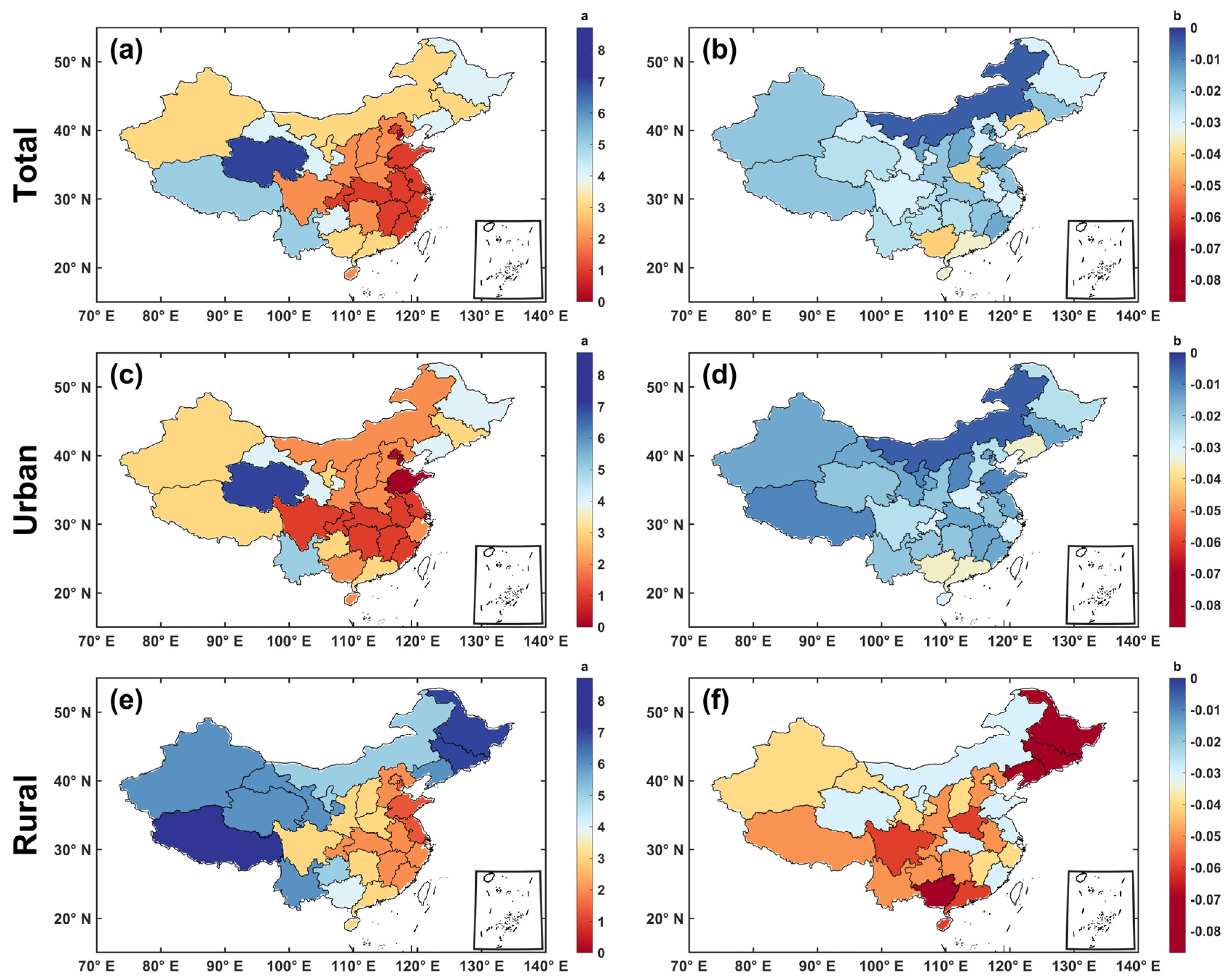


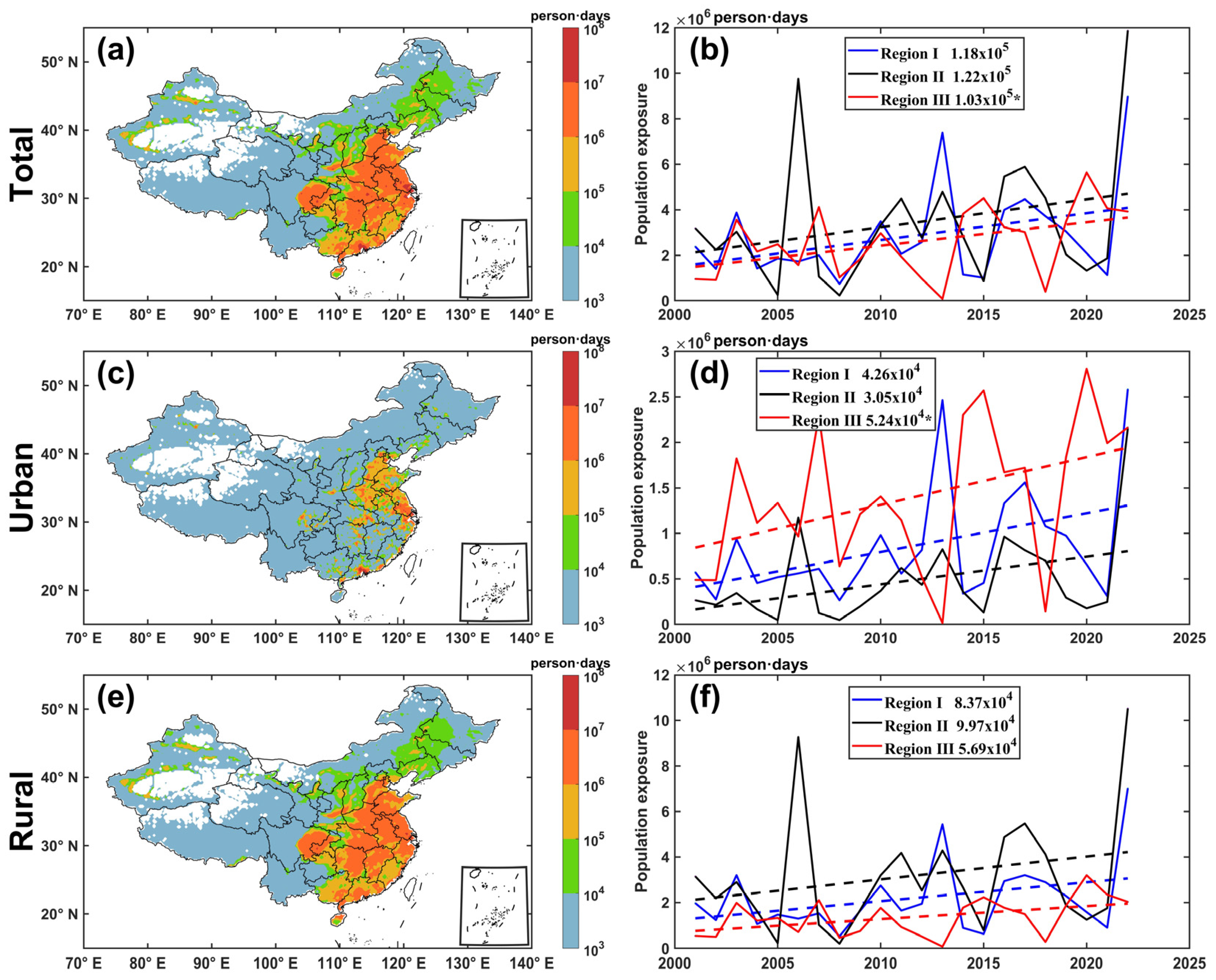

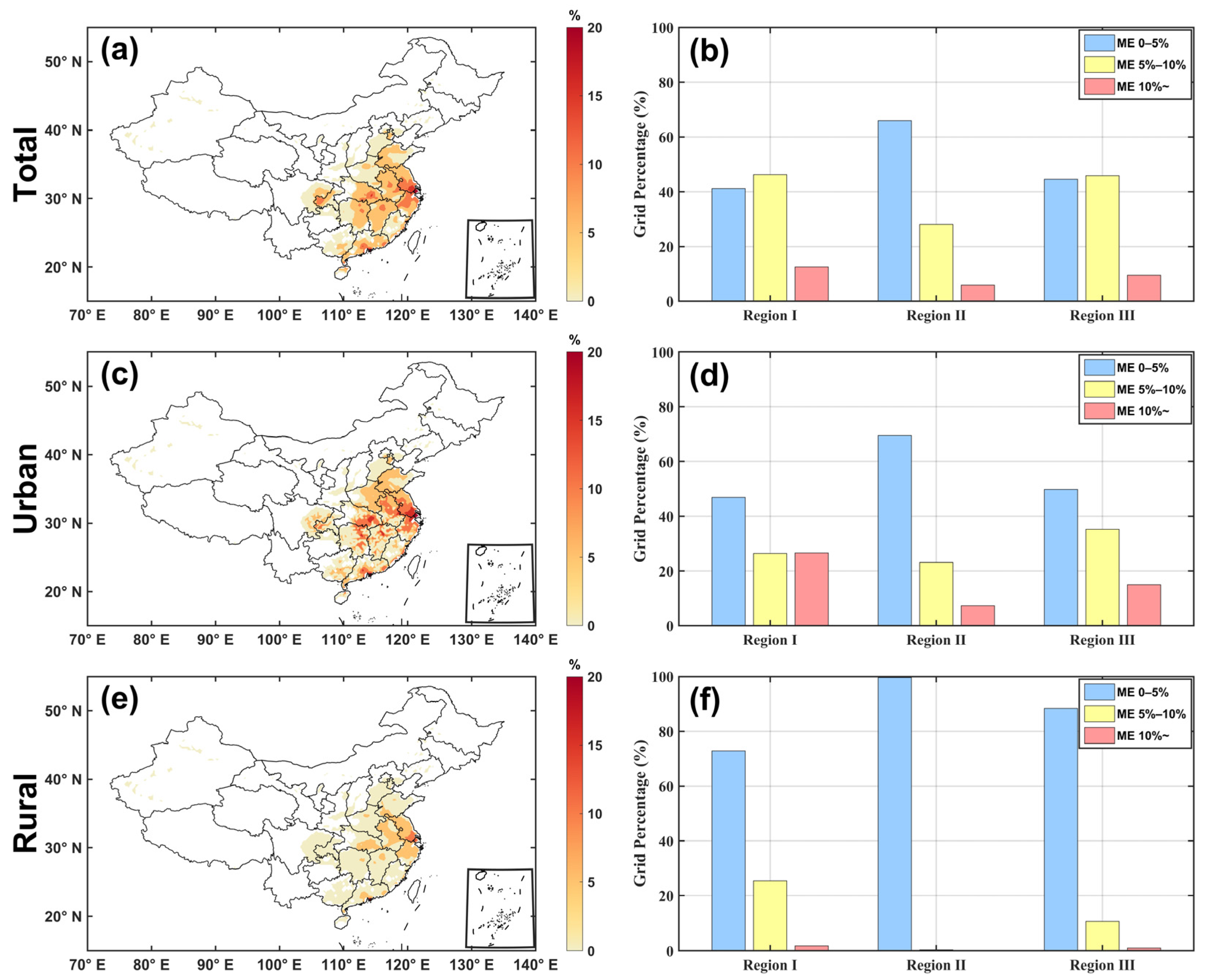

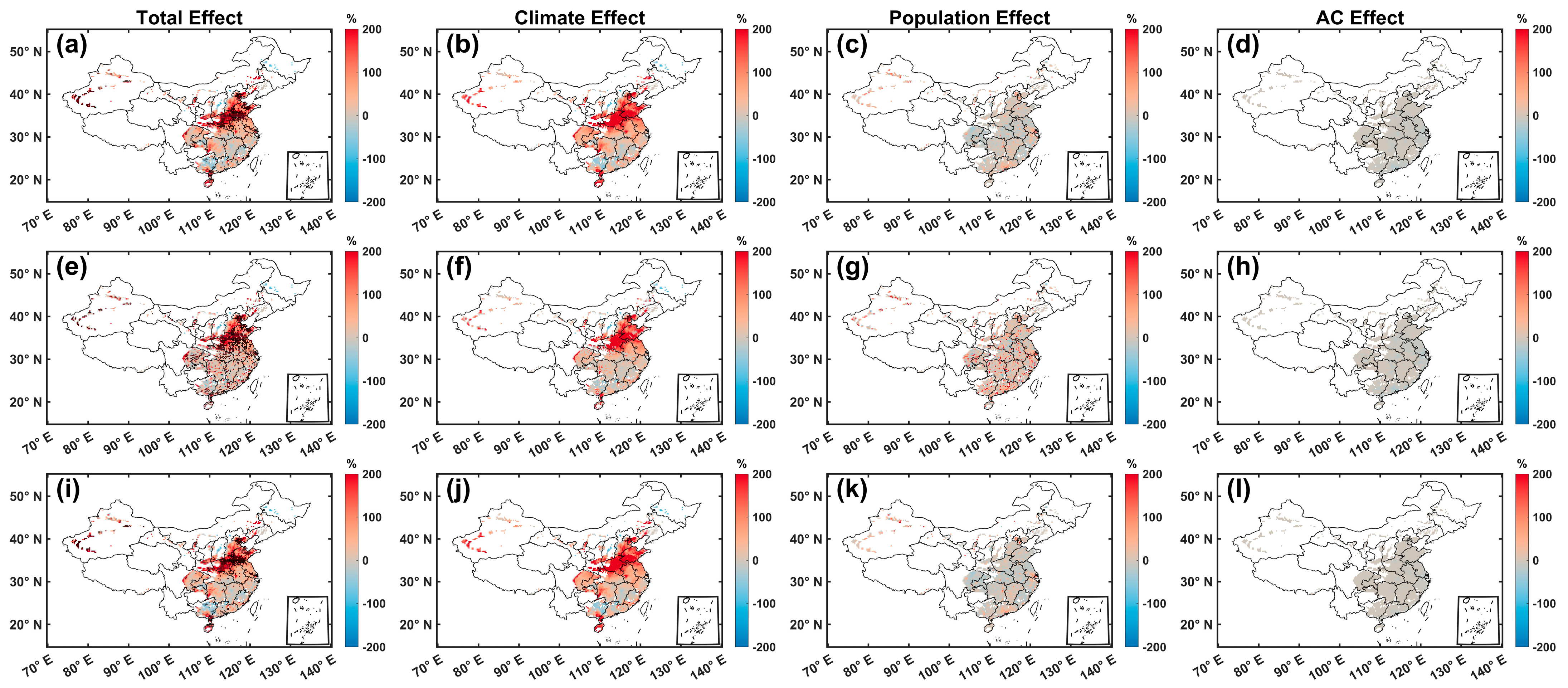
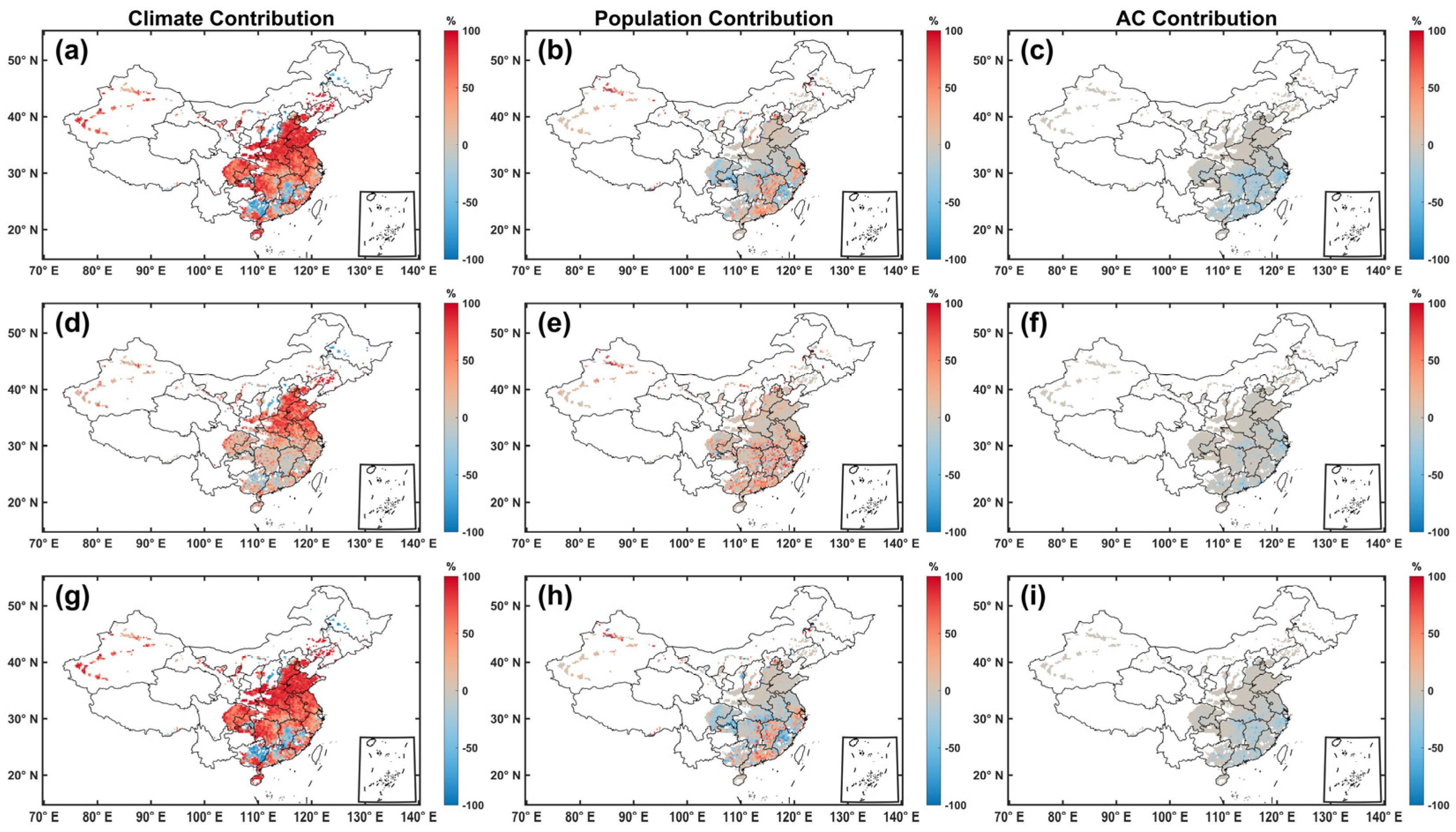
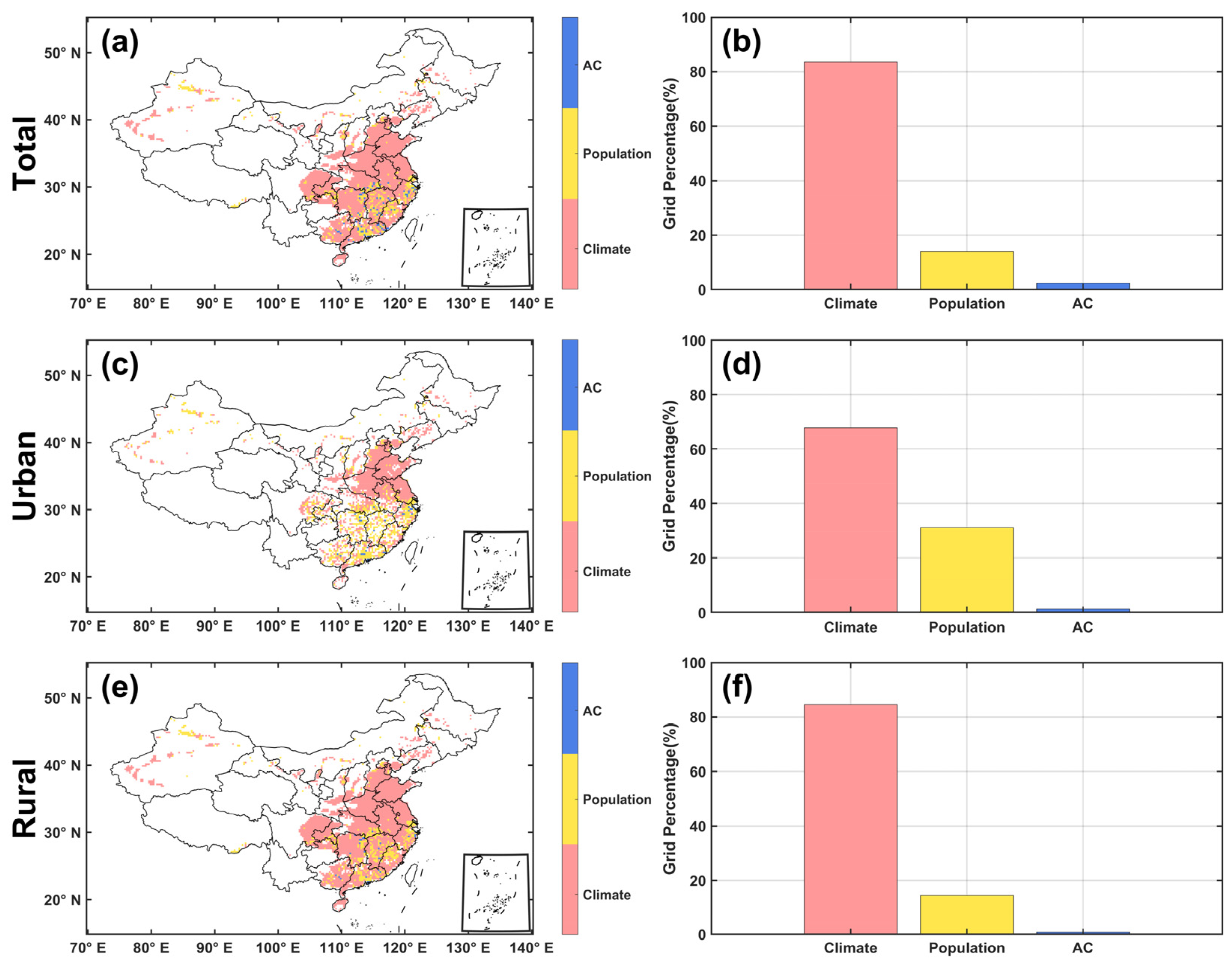
| Type | Data | Spatial Resolution | Temporal Resolution | Period | Source |
|---|---|---|---|---|---|
| Meteorological data | 2 m temperature (°C) | 0.25° × 0.25° | day | 1961–2022 | China Meteorological Administration [41] |
| Land use data | GAIA | 30 m | year | 2001–2018 | Tsinghua University [43] |
| Socioeconomic data | population | 1 km | year | 2001–2022 | Oak Ridge National Laboratory [45] |
| GDP per capita (USD) | 1 km | year | 2001–2022 | Aalto University [47] | |
| GDP per capita (CNY) | province -level | year | 2015–2022 | China Statistical Yearbook [46] | |
| disposable income per capita (CNY) | province -level | year | 2015–2022 | ||
| number of ACs per 100 households | province -level | year | 2015–2022 | ||
| average household size | province -level | year | 2015–2022 | ||
| CPI | province -level | year | 2001–2022 | ||
| PPP | national -level | year | 2001–2022 | World Bank [48] |
Disclaimer/Publisher’s Note: The statements, opinions and data contained in all publications are solely those of the individual author(s) and contributor(s) and not of MDPI and/or the editor(s). MDPI and/or the editor(s) disclaim responsibility for any injury to people or property resulting from any ideas, methods, instructions or products referred to in the content. |
© 2025 by the authors. Licensee MDPI, Basel, Switzerland. This article is an open access article distributed under the terms and conditions of the Creative Commons Attribution (CC BY) license (https://creativecommons.org/licenses/by/4.0/).
Share and Cite
Wang, Y.; Ma, F. The Role of Air Conditioning Adaptation in Mitigating Compound Day–Night Heatwave Exposure in China Under Climate Change. Atmosphere 2025, 16, 912. https://doi.org/10.3390/atmos16080912
Wang Y, Ma F. The Role of Air Conditioning Adaptation in Mitigating Compound Day–Night Heatwave Exposure in China Under Climate Change. Atmosphere. 2025; 16(8):912. https://doi.org/10.3390/atmos16080912
Chicago/Turabian StyleWang, Yuke, and Feng Ma. 2025. "The Role of Air Conditioning Adaptation in Mitigating Compound Day–Night Heatwave Exposure in China Under Climate Change" Atmosphere 16, no. 8: 912. https://doi.org/10.3390/atmos16080912
APA StyleWang, Y., & Ma, F. (2025). The Role of Air Conditioning Adaptation in Mitigating Compound Day–Night Heatwave Exposure in China Under Climate Change. Atmosphere, 16(8), 912. https://doi.org/10.3390/atmos16080912






